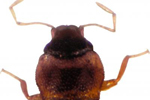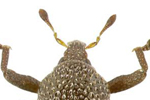If you thought of the little beetle that you saw the other day as just a ‘regular one’ then this might interest you. Scientists from the University of Alaska discovered Nicrophorus efferens, a new species of burying beetle from Solomon Islands. Studying six adult specimens borrowed from the Bernice Pauahi Bishop Museum of Hawaii (BPBM), Dr Sikes and Tonya Mousseau describe the new species in a detailed taxonomic assessment published in the journal Zookeys, and how it differs from two closely related species of the Solomon Islands.
“Without my background and training in the taxonomy of beetles, particularly the burying beetles, this new species might never have been uncovered,” said Mousseau. “This really reinforces the idea that classic training in taxonomy and systematics is absolutely necessary to discovering and understanding the biodiversity of earth.”
 Specimens from Bernice Pauahi Bishop Museum, Hawaii. Source: Sikes DS, Mousseau T (2013) Description of Nicrophorus efferens, new species, from Bougainville Island (Coleoptera, Silphidae, Nicrophorinae). Zookeys 10.3897/zookeys.311.5141 |
While beetles are the largest order of insects on this planet, comprising 30% of all animals, the majority of beetle species have yet to be described. Burying beetles are primarily black with red markings on their forewings, and are named for their tendency to bury the carcasses of dead animals before consuming them. Impressively, these beetles are capable of detecting dead carcasses from as far away as two miles, and they exhibit remarkable parental care similar to ants and honeybees.
Although Nicrophorus efferens is closely related to the two known species from Solomon Islands, it has a unique forewing structure that was first brought to light by scientific scrutiny. Considering the estimated 850,000 – 4,000,000 beetle species on this planet, identifying these minuscule-yet-unique characteristics demands considerable hard work and knowledge.
“It was a bit of good luck that led to our realization these specimens belonged to an undescribed species,” commented Sikes of the University of Alaska. “My student, Tonya, was visiting Hawaii for some R&R and decided to look over the burying beetles held by the Bishop Museum. Her PhD research was focused on the biogeography and evolution of a subgroup of these beetles and she identified these six specimens as very interesting and possibly new.”
Science routinely yields surprises like these out of things that are often considered normal or mundane, but it takes keen knowledge and enthusiasm to discover something new in a heap of archived specimens.
“The discovery of new species in old collections is a common occurrence and one of the many reasons why museums like the Bishop play a vital role in helping us understand life on this planet,” said Sikes.
CITATION: Derek S.Sikes, Tonya Mousseau (2013) Description of Nicrophorus efferens, new species, from Bougainville Island (Coleoptera, Silphidae, Nicrophorinae). ZooKeys
Related articles
New species of beetle discovered in megacity

(10/30/2013) When imagining the discovery of a new species, most people conjure thoughts of intrepid explorers, battling the odds in remote rainforests. But this needn’t be the case, at least according to a new study published in Zookeys. The study reports the discovery of a new species of water beetle in the heart of the 10th largest megacity in the world: Manila, Philippines.
New long-horned beetle discovered in China

(07/03/2013) Recent expeditions by the Chinese Academy of Science’s Institute of Zoology to the Yunnan Province of China have uncovered the existence of a new species of long-horned beetle. This newly discovered beetle has a beautifully colored blue-green body with short, slender, and distinctively blue legs according to a new article in Zookeys.
Scientists describe over 100 new beetles from New Guinea

(06/03/2013) In a single paper, a team of researchers have succinctly described 101 new species of weevils from New Guinea, more than doubling the known species in the beetle genus, Trigonopterus. Since describing new species is hugely laborious and time-intensive, the researchers turned to a new method of species description known as ‘turbo-taxonomy,’ which employs a mix of DNA-sequencing and taxonomic expertise to describe species more rapidly.